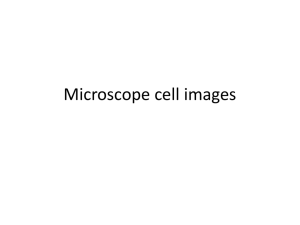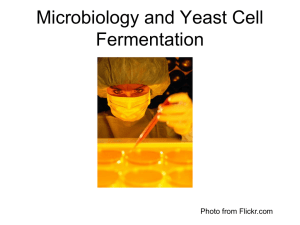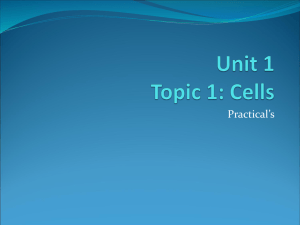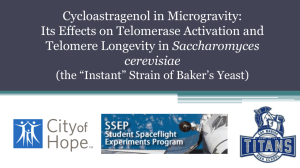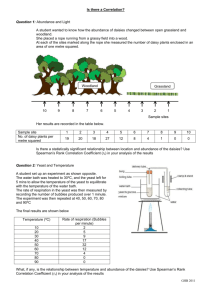Pupil worksheets
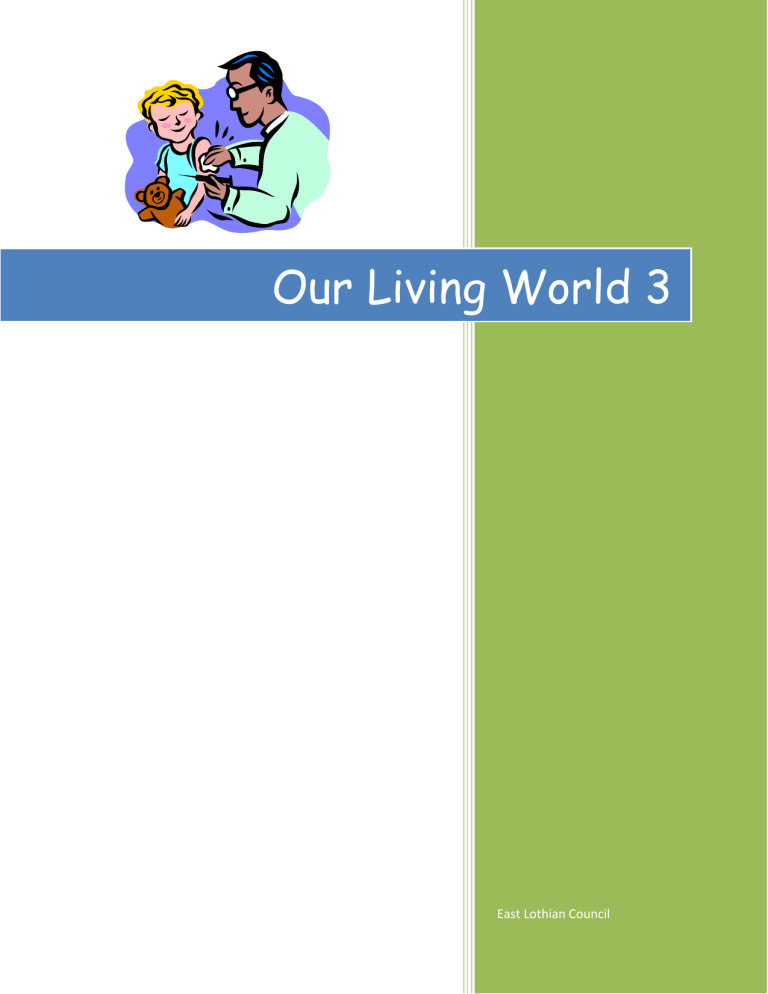
Our Living World 3
East Lothian Council
1.
What are microbes?
In this lesson you will find out why microbes are important – they have many different roles to play in our lives. Some are very useful while others are harmful.
There are five types of microorganisms.
1.
2.
3.
Bacteria
Viruses
Fungi
4.
5.
Algae
Protozoa
In this lesson we will focus on bacteria, viruses and fungi. Your teacher will now talk you through a PowerPoint on these types of microorganisms.
NOTES Copy and complete the sentences using the words in the word bank on the next page.
Microbes are tiny living things which can only be seen with a
__________.
Bacteria can cause diseases such as _______, sore throats and food poisoning. Some bacteria are useful, for example making yoghurt and cheese.
_______ are much smaller than bacteria. They are harmful and cause diseases such as flu, chicken pox and colds.
_____ include moulds such as those which grow on old bread.
Some skin diseases are caused by fungi (_________ ____ and ringworm). _____ is a type of fungus and is used in brewing and baking.
1
WORD BANK athlete’s foot yeast fungi viruses microscope cholera
TASK: Your teacher will now give you a task to do which will allow you to investigate one microorganism in detail.
QUIZ: You will now finish with a quiz on diseases that are caused by microorganisms.
2
2. Microbe reproduction
In this lesson we are going to learn about how microbes reproduce. First of all, we need to learn about the structure of bacteria, viruses and fungi.
NOTES: Find diagrams on the internet of each of the three cells and copy them into your jotter, then copy and complete the table below.
Feature Fungi Bacteria Virus
Cell membrane
Cell wall
Nucleus
√
√
√
Microbe reproduction
Listen to your teacher’s presentation on microbe reproduction. Then answer the following questions in your jotter in sentences.
1.
How do bacteria reproduce?
2.
Where do viruses reproduce?
3.
Name and explain one way that fungi can reproduce.
4.
Name the 4 things that bacteria and fungi need to grow.
5.
Why is the world not over-run with microbes?
Extension task: Food Poisoning
In the table below, there is information about the number of cases of food poisoning reported in Scotland from 1990 until 2010.
3
Year 1990 1995 2000 2005 2010
Number of cases of food poisoning
2700 4200 6800 9300 9500
ACTIVITY: Draw a bar chart of the number of cases of food poisoning reported in Scotland from 1990 until 2010.
Label the horizontal axis ‘Year’ and the vertical axis ‘Number of cases of food poisoning in Scotland’.
When you have completed the graph, answer these questions in sentences in your jotter.
1.
What does your bar chart tell you about the number of cases of food poisoning in Scotland between 1990 and 2010?
2.
During which two years was there the greatest increase in food poisoning?
3.
During which two years was there the smallest increase in food poisoning?
4.
What do you think might cause food poisoning?
5.
How do you think food poisoning could be prevented?
4
3. Where are microbes found and how effective is an antibacterial cleaning product?
In this lesson you are going to collect and grow microbes that are present around you. You are then going to investigate how effective an antibacterial spray is at removing the microorganisms.
Before you begin you must wash your hands!
ACTIVITY: Where do microbes live?
Collect: Clean cotton buds
Clean, fresh tap water
Sellotape and scissors
Marker pen
A sterile nutrient agar plate
2 x paper towels
Antibacterial spray
1.
Choose an area that you wish to test e.g. a desk, a tap or a door handle – think about items that lots of people touch.
2.
Label the underside of a nutrient agar plate with your initials and the date and divide your plate into two halves
(as shown in the diagram below).
Name
Date
X Y
Label
5
3.
Turn the plate over but do not yet lift the lid.
4.
Take a clean cotton bud and dip it in fresh, clean water.
Rub the cotton bud over the surface you have chosen and then rub it gently on to side X of the agar.
5.
Replace the lid and place the cotton bud in the bin.
6.
Now use the antibacterial spray to thoroughly clean the area you have tested.
7.
Take a clean cotton bud and dip it in fresh, clean water.
Rub the cotton bud over the surface you have cleaned and then rub it gently on to side Y of the agar.
8.
Tape the lid to the base with a small piece of sticky tape on opposite sides of the plate.
You must tape the plates closed and not open them again. This is because you do not know what microorganisms will grow and some could be harmful.
9.
Now wash your hands again and incubate the plate for five days at 30°C or seven days at room temperature.
NOTES
Write a report about your experiment – use the following headings:
Title
Aim – what were you trying to find out in this experiment?
Method – how did you do the experiment? Include a labeled diagram of your petri dish.
Results - (you’ll fill this in during the next lesson)
Conclusion - (you’ll fill this in during the next lesson)
ACTIVITY
Collect the word search and find 23 words that are connected with microbes.
6
4. Spread of infection
Firstly, collect your plate from the last lesson and examine it – but do not remove the sellotape because the microbes in it could be harmful.
Now complete your report on the investigation that you started last lesson.
NOTES
Results – describe what you can see on both sides of the plate. Include a labeled diagram of your plate.
Conclusion – did the antibacterial spray remove some of the microbes or was there no difference between the two sides of the plate?
Routes of transmission
Your teacher will now show you a PowerPoint and video clips about how diseases can be spread.
How can the spread of disease be prevented?
Take 5 minutes and have a thought shower with your partner on how we can stop diseases from being spread. You should be able to think of at least 5 ways.
5 ways we can stop diseases from being spread are:
7
Extension
Your task is to produce a leaflet giving information to school pupils on how to wash their hands properly.
8
5. Investigation into Flu and HIV
Your task is to investigate and prepare a PowerPoint presentation on Flu or HIV with a partner. Your presentation should answer these questions:
What is HIV/Flu?
How is HIV/Flu caused?
Is there a cure for HIV/Flu?
How can the spread of HIV/Flu be prevented?
You should also add information on another area you find interesting e.g. you could talk about swine flu or HIV in Africa.
Your presentation will be marked out of 5 and you will gain marks for the following things.
Marks awarded for…
Answering the four questions at the top of the page.
Number of marks awarded
1
1 Going into detail about another aspect of HIV/Flu that you’re interested in.
Putting the information into your own words.
Having well laid out and clear slides.
Including relevant pictures.
1
1
1
9
You have this lesson to research and prepare your presentation.
Please ensure you save it to your area on the server. Next lesson you will be presenting it to the class.
Suggested website are:
For HIV: http://www.nat.org.uk/HIV-Facts.aspx
(google search - nat hiv school and select the HIV facts link) http://www.nhs.uk/conditions/hiv/pages/living-with.aspx
(google search - nhs hiv) http://www.sciencemuseum.org.uk/WhoAmI/FindOutMore/Yourb ody/Whatdoesyourimmunesystemdo/WhatisAIDS/HowdoesHIVa ffectthebody.aspx
(google search - science museum hiv)
For Flu: http://www.nhs.uk/Conditions/Flu/Pages/Introduction.aspx
(google search - nhs uk flu) http://www.patient.co.uk/health/influenza-immunisation (google search - patient influenza) http://www.blf.org.uk/Conditions/Detail/Flu (google search - blf flu) http://www.pagb.co.uk/publications/pdfs/fluleafletblackandwhit eversion.pdf
(google search - pagb flu pdf)
10
6. Presentations on Flu and HIV
In this lesson, you’ll be presenting and assessing the presentations of your peers on Flu and HIV. Copy the table below into your jotter before the presentations begin. Use ticks or crosses to show if you would award the presenter the mark for each question.
Presenters initials
Did they?...
Answer the 4 questions?
Go into detail about another aspect of
HIV/Flu?
Put the information into their own words?
Have well laid out and clear slides?
Include relevant pictures?
11
7. Vaccinations
In this lesson you’ll learn about vaccinations and you’ll have the chance to talk about some issues in this area.
12
8. Treatment and prevention of infection
In this lesson we will focus on the treatment of an infection called MRSA and the prevention of the HPV virus. Firstly, watch the short video your teacher will show you on microbes.
Now watch the animation on MRSA that your teacher will show you. After this, collect the worksheet from your teacher on MRSA. Read it carefully and answer the questions in sentences in your jotter.
Now we will look at how some viruses can be prevented. Your teacher will talk you through a PowerPoint – glue the diagram you’ll be given into your jotter.
HPV is a vaccination that is given to all girls in Scotland aged 12-13. Read the information leaflet about HPV and answer the questions below in your jotter in sentences.
1.
What can HPV cause?
2.
How do people get HPV?
3.
Is HPV rare?
4.
By what percent will girls who have the HPV vaccination reduce their risk of getting cervical cancer by?
5.
How many injections do girls need to be fully immunised?
6.
What are the side effects of the HPV vaccination?
7.
Who should girls discuss getting the vaccine with?
8.
What should girls do if they miss any vaccination?
9.
Will girls who have had the vaccine still need smear tests?
10.
If the answer to question 9 is yes, why?
13
9. Using bacteria to make yoghurt and cheese
In this lesson we are going to learn how we can use bacteria to make yoghurt and cheese. We will then make yoghurt!
Let’s start by refreshing our memories on bacteria. Answer the following questions in sentences in your jotter – use information from lessons 1 and 2 to help you.
1.
What illnesses can bacteria cause?
2.
Where in our body do we need bacteria to keep us healthy?
3.
How do bacteria reproduce?
4.
What 4 things do bacteria need to reproduce?
5.
What can bacteria be used to make?
Your teacher will now show you a PowerPoint on making cheese and yoghurt and you will watch some videos of them being made.
Pay close attention – there is a quiz at the end of the PowerPoint!
14
Experiment: Making yoghurt
Collect the following equipment:
A plastic cup.
A small piece of cling film.
A plastic table spoon.
1.
Fill your plastic cup ¾ full with UHT milk.
2.
Add a tablespoon of the natural yoghurt (this contains live bacteria).
3.
Mix well.
4.
Put cling film over the top of your cup.
5.
Put your cup into the yoghurt maker (this keeps it warm).
Next lesson we will measure the pH of the contents of the cup to work out if it’s turned into yoghurt.
Remember - you cannot eat the yoghurt because it has been made in a laboratory!
You can now do a word search on different types of cheese.
15
10. What can yeast do for us?
Yeast is used in the brewing industry to make beer and wine. The name of the process is fermentation. In your lesson today, you are going to find out about fermentation.
COPY
Fermentation is a process carried out by micro-organisms to produce energy for their growth and reproduction. Alcohol and carbon dioxide are produced if no oxygen is present.
ACTIVITY: Investigating fermentation
COLLECT: Small plastic bottle
Balloon
Spoon
Lime water
Sugar
Dried yeast
Test tube
1.
Add warm water to the bottle until it is half full.
2.
Add 4 spoonfuls of sugar to the water and mix thoroughly to dissolve the sugar.
3.
Add two spoonfuls of yeast and mix.
4.
Seal top of the bottle with a balloon
Water + yeast + sugar
16
5.
Leave in a warm place for 30 minutes (until the balloon inflates).
6.
Pour about 2 cm. depth of lime water into a test tube.
7.
Pinch the neck of the balloon to seal it and transfer the gas inside the balloon to the test tube. Put your thumb over the test tube to seal it and shake gently. If the limewater goes cloudy, then carbon dioxide is present.
Squeeze gently
Gas
NOTES
Lime water
Write a report about your experiment. Use these headings and answer the questions.
Title
Aim – what were you trying to find out in this experiment?
Method – how did you do the experiment? Include a labeled diagram of equipment.
Results: o What happened to the balloon? o What happened to the limewater?
Conclusion: o What caused the balloon to change? o What caused the limewater to change (if it did)?
17
o What provided food for the yeast? o What gas was produced by fermentation of yeast?
EXTENSION
Read page 71 in Starting Science book 2 and answer questions 1-
4 in your jotter in sentences.
18
11. Microbes and Bread Making
Bakers add yeast to dough to make it rise. Yeast feeds on sugar in the dough and produces bubbles of carbon dioxide. This process is called fermentation. The bubbles makes the dough swell. During the baking of the bread, the yeast is killed and fermentation stops.
You are going to perform an investigation, which you will write up.
It will be assessed by your teacher.
Please read the standard recipe for making dough on the next page then listen to your teacher as he/she talks you through a PowerPoint on designing experiments.
Answer these questions in sentences:
1.
Select a variable to investigate. Remember – a variable is
something in an experiment that you change. What variables could you change in this experiment?
2.
What will you measure in your experiment?
3.
You’ll need a version of the experiment with the basic setup in normal conditions, so that you can observe the effect of changing the independent variable. This is called a control.
What will your control be?
4.
Draw your experiment, showing the equipment needed and how you are changing your independent variable.
19
5.
Create a table for how you record your results. Remember - you’re taking measurements every 5 minutes for 30 minutes.
Share the answers to these questions with your teacher before you start your experiment.
Standard Recipe for Making Dough
Equipment needed
50 cm 3 measuring cylinder
Plastic cup
Marker pen
Plastic spoon
Instructions
Add the flour to a beaker and then add 1 spoonful of sugar.
Measure 50cm 3 yeast suspension using a small measuring cylinder. Add it to the flour and sugar in the beaker. Stir.
Carefully pour the paste into the plastic cup. Do not allow the paste to touch the side of the cup. Label the cup near the top with your name and mark the level of the paste using the pen.
Leave the cup on the bench at room temperature.
Mark the height of the paste every 5 minutes for 30 minutes.
20
12. Writing up a scientific report
In this lesson you will write up your results from last lesson in the format of a scientific report. Your teacher will now run through a PowerPoint presentation with you to give you more detail on how to write the report.
Your report should have the following sections in it.
Title
Aim
Introduction (including your hypothesis)
Method
Results o Include your table o Draw a line graph showing the height of dough every 5 minutes from 0 to 30 minutes. Hint – your graph will have 2 lines on it – one for your control condition and one for your independent variable.
Conclusion (what do your results tell you – what effect does the independent variable have on the dependent variable?)
You can look at the information from the PowerPoint on the next pages to help you with your report. Remember – your teacher will be assessing your report!
21
22
23
13. Immobilising Yeast
As we have found out during this course, yeast is a microbe.
Answer these revision questions in your jotter in sentences – use information from lessons 1 and 2 to help you.
1.
How many cells is yeast made up of?
2.
What type of microbe is yeast?
3.
What can yeast be used to make?
4.
How do yeast cells reproduce?
5.
What 4 conditions do fungi need to reproduce?
In this lesson we will use a technique called immobilisation.
Immobilisation is a way of trapping valuable resources so that they can be used again. In this experiment, we will trap yeast cells in pellets of gel. The advantages of doing this are:
It is easier to separate the yeast from the end product.
The yeast can be reused.
The trapped yeast could then be used to make Kefir. Kefir is a fermented milk drink that has been produced for many years by people in Eastern European countries. It is slightly sour, fizzy and contains alcohol.
24
Experiment: trapping yeast in jelly beads
Collect your equipment:
2cm 3 yeast solution
8cm 3 sodium alginate
A 10cm 3 syringe
A small measuring cylinder
50cm 3 calcium chloride
A tea strainer
A glass stirring rod
2 beakers
Perform the experiment by following these stages.
1.
In a beaker, add the yeast and sodium alginate.
2.
Stir the mixture using a stirring rod.
3.
Draw the mixture up into the syringe.
4.
Add the calcium chloride to another beaker – use a measuring cylinder to measure the volume.
5.
Carefully add the contents of the syringe to the calcium chloride, one drop at a time. Try and make your beads all the same size and shape.
6.
Leave the jelly beads in the calcium chloride for ten minutes to let them set and tidy away the equipment that you have used.
7.
Empty the beads into the tea strainer over a sink and rinse them with cold water. Job done!
25
Copy this note:
Yeast can be immobilised in jelly beads. This technique is used in industry because it is easier to separate the yeast from the end product and the yeast can be reused. Immobilised yeast is used to make Kefir, which is a slightly alcoholic milk drink which originated in Eastern European countries.
26
14. Are Biological Washing Powders Effective?
We need food to give us energy. Some foods need to be broken down before we can use them. This breaking down of the large units of food into smaller ones is called digestion.
Our bodies use enzymes to digest food. So, enzymes help to break down large units of food into smaller ones.
Enzymes are also used in Biological Washing Powders. They break stains so that the stain is removed. Non-biological washing powders do not have enzymes in them, but are kinder to skin.
To see how an enzyme can break down food you are going to carry out an experiment.
ACTIVITY 1: Experiment to investigate the effect of washing powders on jelly
Jelly is made of a protein called gelatin. When the protein is digested by enzymes, it dissolves.
COLLECT: - A dish containing coloured jelly
Non-biological washing powder
Biological washing powder
A spoon
Non-biological washing powder
Biological washing powder
27
1.
Add one spoonful of non-biological powder and one of biological powder to the jelly as shown in the diagram. Make sure you can identify each powder!
2.
Leave your dish in a warm place until the end of the lesson.
COPY AND COMPLETE
We did an experiment to investigate whether biological or nonbiological washing powder dissolved jelly first. We found that -
___________ washing powder dissolved the jelly first. This is because it contains ______________ that digest _________.
ACTIVITY 2: Experiment to investigate the effect of washing powders on stains
Stains like egg, gravy and blood are difficult to remove. You are going to perform an experiment to investigate whether biological or non-biological washing powder remove them better.
COLLECT: - Non-biological washing powder
Biological washing powder
A spoon
2 beakers of the same size
2 cloths both stained with egg or lipstick
A glass rod
1.
Label your beakers 1 and 2.
2.
Place one level spoonful of biological washing powder in beaker 1 and dissolve it in 50ml of warm water.
3.
Place one level spoonful of non-biological washing powder in beaker 2 and dissolve it in 50ml of warm water.
4.
Add one piece of cloth with the same stain to each beaker and stir.
28
5.
Place the beakers in a waterbath at 40 0 C and stir every 5 minutes for 20 minutes.
6.
Rinse the stained material using cold water and leave it to dry.
Write up your experiment using these headings:
Title
Aim
Method (include a labeled diagram)
Results
Conclusion
29

